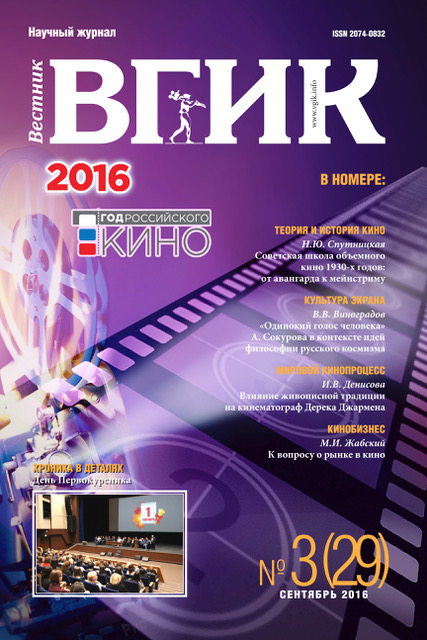The Influence of the Painting Tradition on Derek Jarman’s Films
- Authors: Denisova I.V1
-
Affiliations:
- ВГИК
- Issue: Vol 8, No 3 (2016)
- Pages: 84-94
- Section: WORLD CINEMA | ANALYSIS
- URL: https://journals.eco-vector.com/2074-0832/article/view/14714
- DOI: https://doi.org/10.17816/VGIK8384-94
- ID: 14714
Cite item
Full Text
Abstract
The article aims at revealing intertextual references to paintings woven into feature films by the British director Derek Jarman (1942-1994). The author explores various manifestations of intertextuality from direct citations to reminiscences, which allow to emphasize the continuity of film-director’s work, the connection of its aesthetics, composition, film mood with the original fine art source paintings. The target is to enhance the emotional impact on the viewer. The concept of “intertextuality” has undergone significant changes since its introduction to the research usage by the poststructuralist French theorist Julia Kristeva. This term has gone beyond the literary discourse and has begun to be used in the analysis of all the semiotic formations to describe the interaction of both verbal and non-verbal texts. In this regard, it is important to analyze and reveal the intertextual references to paintings woven into feature films made by a British director Derek Jarman whose works are insufficiently explored in Russia. Intertextuality is a characteristic feature of Jarman’s creative style that seeks to blur the clear distinction between painting and cinema. Analysing the influence of such artists as Michelangelo Merisi da Caravaggio, Piero della Francesca, William Turner, Ford Madox Brown, Thomas Eakins and Francis Bacon on Jarman, the author reveals the interconnection between the director’s aesthetics, composition, mood, light and shade frame modeling and the original paintings. Derek Jarman uses a variety of intertextual references from direct citations to reminiscences affecting the visual associative row of the audience and their film perception, emphasizing the continuity of his work. The intertextual references seek to enhance the emotional impact on the viewers, to recreate the mood of the epoch and its atmosphere, to aggravate the tragedy of the situation. The metaphors and allusions greatly expand the spatial and temporal characteristics of Jarman’s films. Numerous intertransitions from one semiotic system to another fill his films with inner dialogue and strengthen semantic polyphony of meaning.
Keywords
About the authors
Irina V Denisova
ВГИК
Author for correspondence.
Email: idenisova@ya.ru
Ass. Professor, Department of Russian and Foreign Languages, VGIK, degree seeker at the Department of Cinema Studies
References
- Кристева Ю. Бахтин, слово, диалог, роман // Французская семиотика: от структурализма к постструктурализму. Сост. ГК. Косиков. М.: Прогресс, 2000. С. 427-457
- Хаксли О. В дороге: пер. с англ. - М.: Б.С.Г.-ПРЕСС, 2005. - 223 с.
- Ямпольский М.Б. Память Тиресия: интертекстуальность и кинематограф. - М.: Культура, 1993. - 464 с.
- Jarman Derek. Dancing Ledge. - London: Quartet, 1984. - 254 p.
Supplementary files








